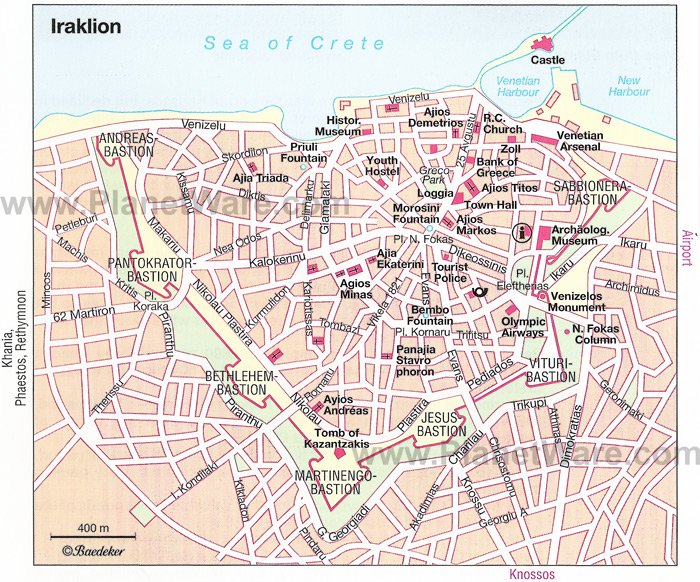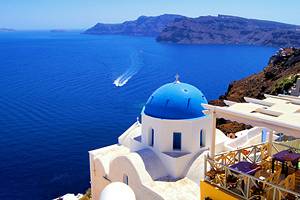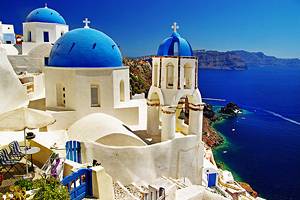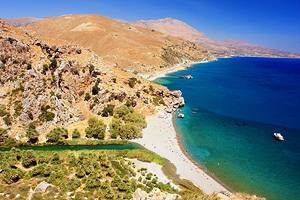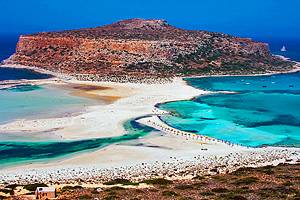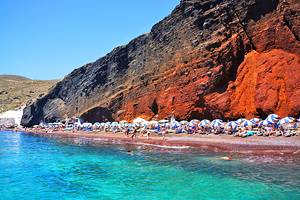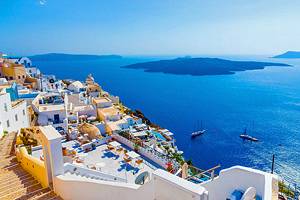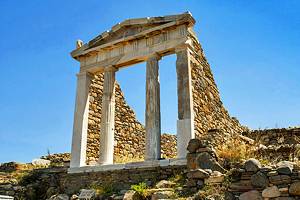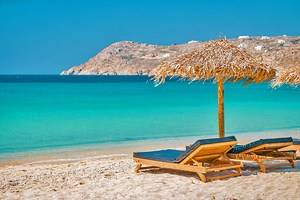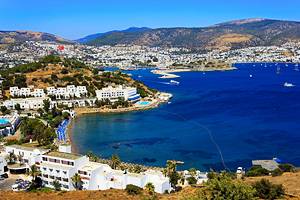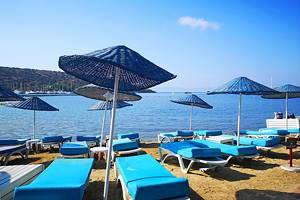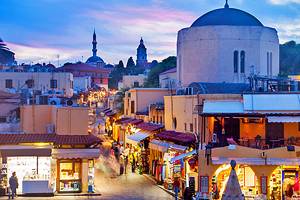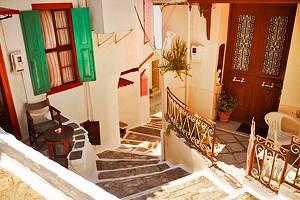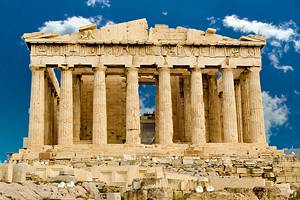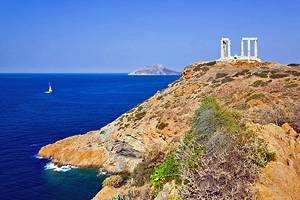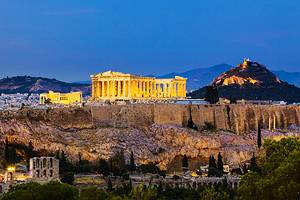Attractions & Things to Do in Heraklion
Many travelers arrive on Crete in Heraklion and continue on to other parts of the island without allowing much time, if any, to see the sites. But this city, the island's capital and chief port, is full of history and attractions in and around the Old City. It has a beautiful waterfront area with seaside restaurants, several important museums, and lovely squares where you can easily spend an afternoon in a street-side cafe. The vibrant Old City is of most interest to visitors, and it's worth taking some time to see.

In ancient times, Heraklion was the port of Knossos, where the Minoans, Europe's oldest known civilization (they lived on Crete between 2700 BC and 1450 BC) traded gold, ceramics, and saffron. Today, visiting the Minoan Palace of Knossos is one of the top things to do in Heraklion.
Enjoy your visit to this city and plan your sightseeing with our list of the top attractions in Heraklion.
The Palace of Knossos
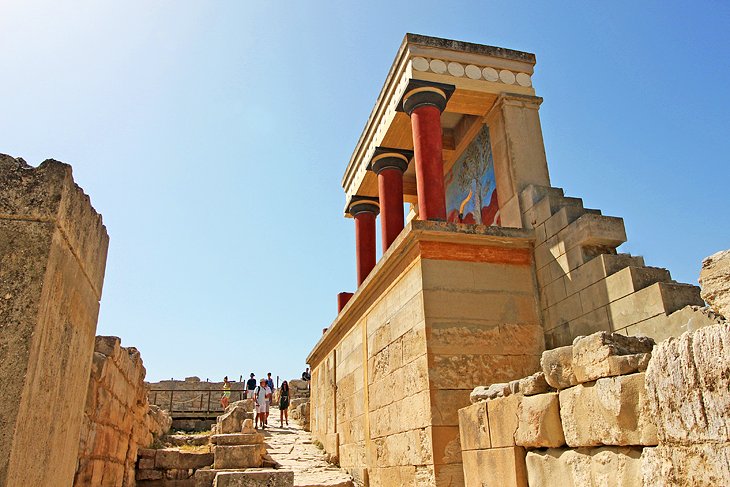
Crete's biggest and best-preserved Minoan site lies just five kilometers southeast of Heraklion. It is one of the most important tourist attractions on Crete.
A vast monumental palace, with four wings built around a spacious central courtyard, Knossos is believed to have been the mythical Labyrinth of King Minos. Remarkably sophisticated, it included ceremonial spaces, living areas, storage rooms, elaborate decoration, and a complex drainage system.
Although excavations show that there was a palace here as early as 2000 BC, what you see today dates mainly from 1450 BC. Take into consideration when touring the site that some slightly over-imaginative reconstruction from the early 20th century has taken place. The frescoes you see are replicas; the originals are in Heraklion Archaeological Museum.
Buses from the Old Town leave every 15 minutes for Knossos during the summer season, making it extremely easy to visit. If you have your own car, parking is free.

Old Town
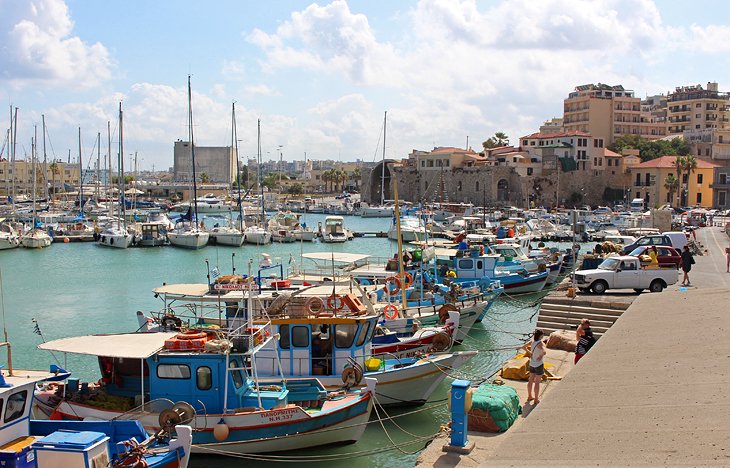
You can easily spend a morning or afternoon strolling around the Old Town, seeing the sites and soaking up the atmosphere. Heraklion grew up around the sea, and still today, the old town focuses on the harbor.
The most notable monument along the harbor is the 16th-century Venetian Fort of Koules. Fishing boats line the shore, where a walkway runs along the waterfront.
Across the road but fronting the harbor are the Venetian Arsenals, easily recognizable by the stone facade and huge archways. This is where the Venetians repaired their ships. To the west of the harbor, the scenic promenade stretches along the sea and is lined with seafood restaurants.
The Old Town is protected by a circuit of massive defensive walls, which have been demolished in parts. Inside, its pedestrian-only streets are lined by aristocratic buildings, churches, and boutiques, and open onto leafy squares with fountains and busy cafés.
Koules Fortress
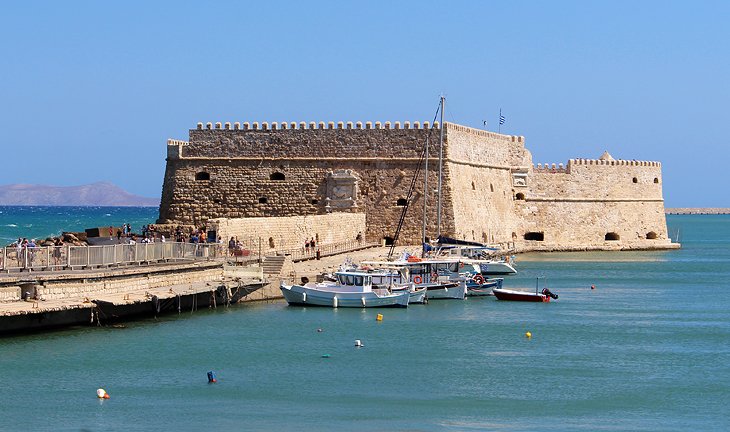
Occupying a prominent position on the waterfront of Heraklion, the Koules Fortress is an impressive Venetian fortress dating from the early 16th century. An easy and scenic walk from the shoreline along a breakwater takes you to the main entrance located on the right-hand side.
Although it's an imposing sight from afar, the recently renovated interior is equally, if not more, impressive. Grand wooden doors open into rooms where period pieces are on display, and plaques offer insight into the history. With walls as thick as 8.7 meters, it's quiet and cool, making it easy to spend time exploring the 26 rooms and vaults. Inside these quiet chambers are historical artifacts like old cannons, amphora (pots), and stone carvings.
Incredible views out to sea and over the harbor towards town can be had by climbing the stairs to the roof. If it's windy, be sure to watch out for sea spray from the waves crashing against the rocks.
Heraklion Archaeological Museum
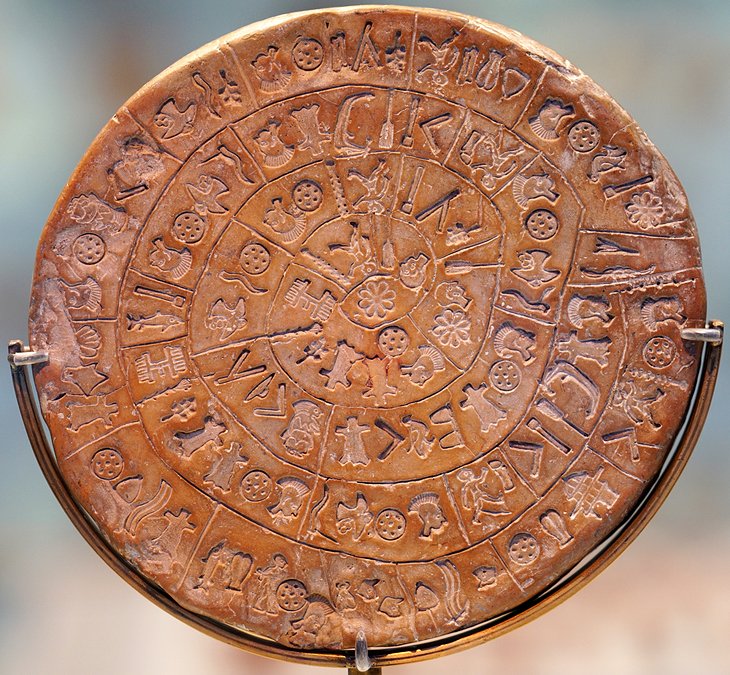
Magnificent 3,500-year-old frescoes from Knossos, including Prince of the Lilies and Bull-Leaping, are on display at this museum. Be sure to check out the Snake Goddess, a glazed ceramic figurine of a lady holding two snakes, dated 1600 BC, and the Phaistos Disk, a clay disc bearing a curious spiral of symbols from around 100 BC.
The museum's treasures are spread out over 27 different galleries and cover more than 5,500 years of history. The courtyard area has the preserved remains of the Venetian Monastery of St. Francis, destroyed in an earthquake in 1856.
This world-class museum is Heraklion's principal tourist attraction, apart from the actual site of Knossos, and lies in the eastern part of the old town.
Address: Xanthoudidou 1, Heraklion, Crete
Natural History Museum of Crete
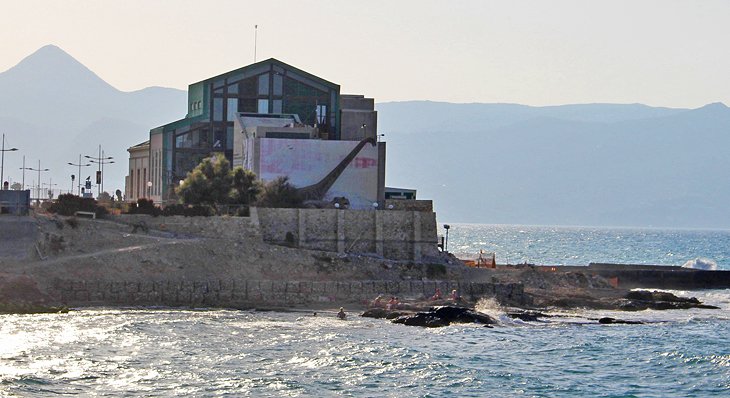
A visit to the Natural History Museum of Crete is an ideal thing to do for families. Situated right on the waterfront and just down from the Historical Museum, this is an impressive modern museum that showcases the best of Crete.
Fun activities for children and adults include an earthquake and tsunami simulator. In addition, an entire floor is devoted to stuffed animals that live or once lived around the Mediterranean Sea. Make sure you try out the illusion exhibit for a mind-bending experience.
Also on display are artifacts from the Palace of Knossos. Displays have information in multiple languages. The building is bright and air conditioned, and makes for a good escape from the mid-day heat in Heraklion.
Official site: https://www.nhmc.uoc.gr/en
Cathedral of St. Minas
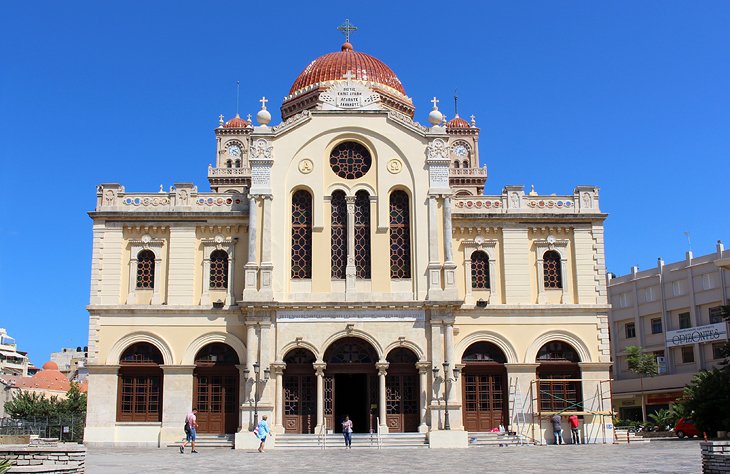
Dedicated to the patron saint of Heraklion, the Cathedral of St. Minas is an impressive building located in the Old Town. Dating from the late 19th-century, this is the largest church in Crete, and it's renowned for its extensive religious iconography.
The church interior has beautifully painted walls lit up by a stunning chandelier. One of the must-see frescoes is located in the dome, showing Christ Pantocrator. In front of the church is a lovely square.
This is an active church with regular services and is also the seat of the Archbishop of Crete.
Historical Museum of Crete
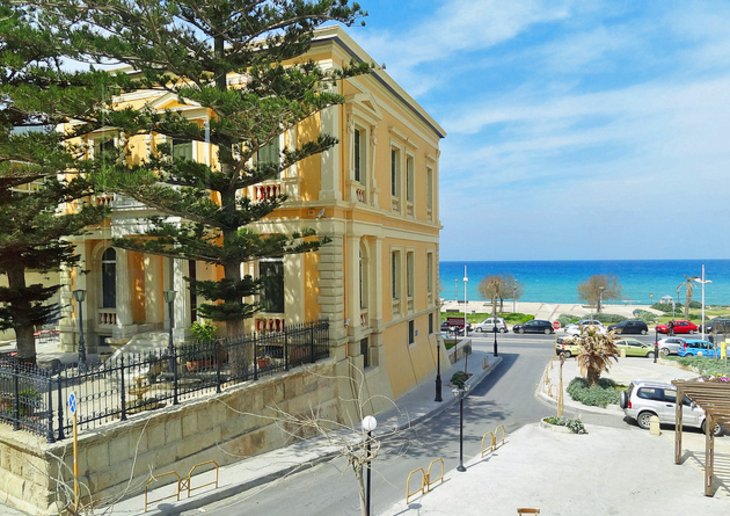
With a succession of foreign occupiers, Crete's history is complicated but fascinating. This museum traces 1,700 years of history on the island, from early Christian times to the modern era.
You'll see religious icons, stone carvings, ceramics, textiles, and folk costumes from the Byzantine, Venetian, and Turkish periods, as well as somber space dedicated to the Cretan Resistance Movement and those who lost their lives during WWII.
Particular highlights include two paintings from the 16th century: The Baptism of Christ and the View of Mt. Sinai and the Monastery of St. Catharine.
Everything is well presented and clearly labeled, and there's a peaceful garden café. You'll find it in a restored neoclassical mansion, a 10-minute walk west of the old harbor.
Address: 7 Lyssimachou Kalokairinou Street, 71202 Heraklion, Crete
Official site: http://www.historical-museum.gr/eng/
Agios Titos Church
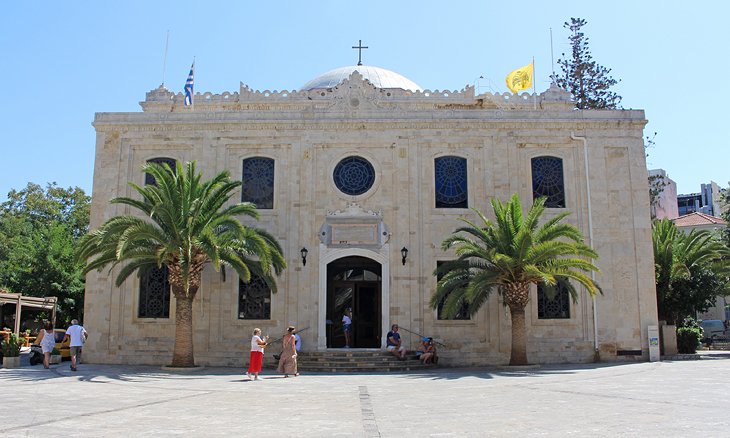
You'll most likely come across this historic church as you walk the pedestrian zone of Heraklion. It is unmistakable, with two massive palm trees in front.
The original Agios Titos Church was built here late in the 10th century. Over the years through a series of earthquakes and disasters, the original buildings tumbled to ruins. The solid looking building that stands here today dates from the mid 19th century and was once a mosque.
If it's open, take a look inside the church and be sure to look up to see the chandeliers. The square in front of the church is leafy and green with several small cafés featuring patio seating.
Morosini Fountain in Lion Square
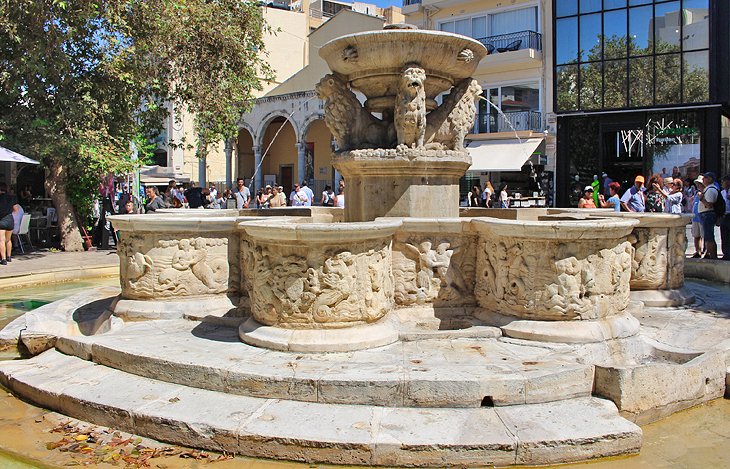
The Morosini Fountain is at the center of Heraklion's Old Town, not far from the Loggia. It's an ideal place to orient yourself as you explore the warren of streets in the surrounding area.
Dating from 1628, this fountain, surrounded by mature trees and cafés, is the center of action in the old city. When the weather is warm, you'll almost always find a lively scene of locals and tourists enjoying the surrounding cafés and ice-cream shops. In the evening, the square around the fountain hums with people enjoying the nearby nightlife.
The Morosini Fountain played an important role in providing drinking water to the citizens of Heraklion. It was originally connected to a 14-kilometer aqueduct and brought water to the city from the slopes of Mt. Juktas.
Restored to its original condition after years of neglect, today the fountain consists of four lions with water pouring out of their mouths into a pool below.
Loggia (Town Hall)
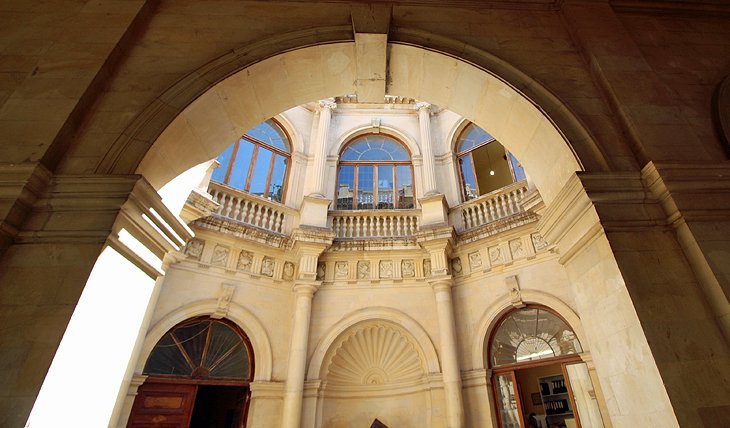
Located in the heart of the Old Town is the Loggia, which today operates as Heraklion's town hall. Considered by many to be Crete's best-preserved Venetian building, this impressive structure is free to enter and worth a quick look. The large shady arcade under the arches is a great place to escape the intense summer sun.
Built by Morosini, the building dates from 1628 and is a reproduction of the famous Basilica in Vincenza, albeit on a much smaller scale.
Nearby is a wonderful area of narrow streets lined with restaurants with patios, as well as interesting shops.
Walking along the Waterfront
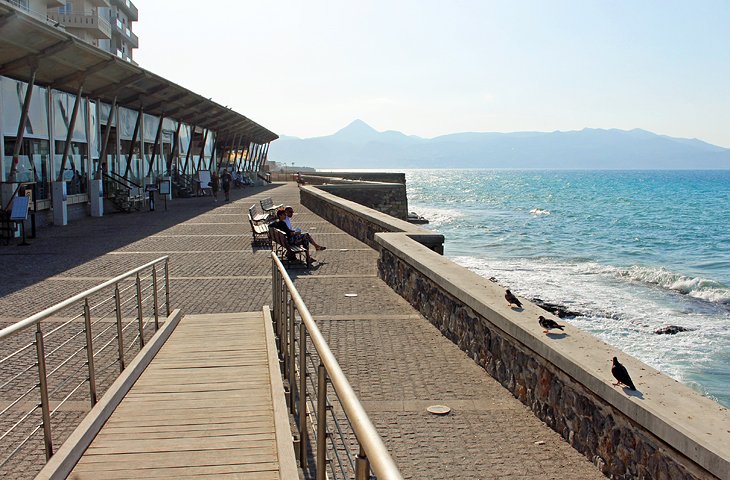
If you've arrived after a long flight or ferry ride and would like to stretch your legs, a stroll along the waterfront is a great idea. Some of Heraklion's best seafood restaurants, an ancient fortress, museums, and amazing views are what you'll find here.
The walks consist of two sections: the main waterfront stroll, running along the sea from east to west; and the breakwater walk, which extends out past the historical fort.
The waterfront stroll starts at the breakwater and runs east to the traffic roundabout past the ancient Venetian arches and west to the Natural History Museum. This is the option you'll want to choose if you want to stop for a bite to eat or learn a bit about the island.
To take the breakwater walk, head towards the ancient Koules Fortress and keep going. This 4.6-kilometer return walk takes you out into the sea and provides great views back towards the city and mountains in the distance. At about the halfway point, some interesting tile work adorns the breakwater.
This can be a hot walk in the middle of the day. The high breakwater stops the prevailing winds, so it can be still and humid and there is no respite from the sun.
Shopping in the Old Town
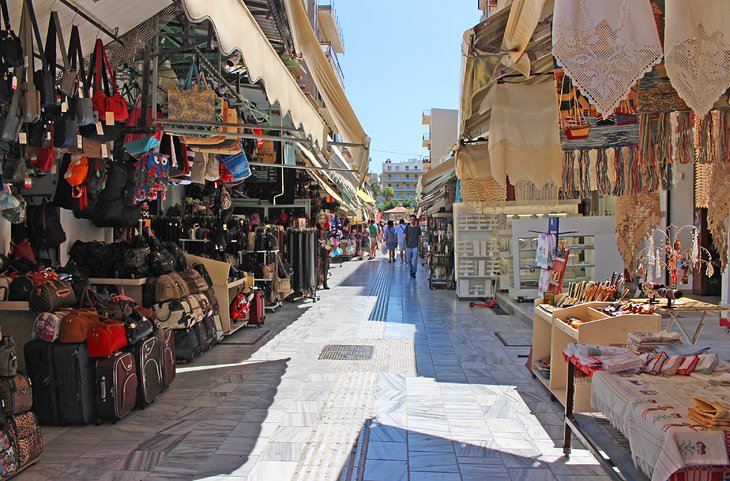
The Old Town of Heraklion has close to 1,000 shops, many of which are found in the extensive maze of pedestrian-only streets. Located in among the narrow streets and alleys, you'll find lovely restaurants, hidden patios, and retail shops selling pretty much anything you can imagine.
If you are on the hunt for the perfect souvenir from Crete, head to the pedestrian-only 1866 Street, known as the Central Market. This narrow street is full of vendors, with wares piled high and spilling out onto tables. You can find shirts, fridge magnets, jewelry, linens, and all manner of kitsch for sale. If you have no room in your bags, don't worry, even luggage to transport all your new purchases is available.
The shops, restaurants, and cafés are literally everywhere in the Old Town. Just pick a street and start walking, take random turns, and you'll be amazed at what you discover.
Walk the Ancient Venetian Walls
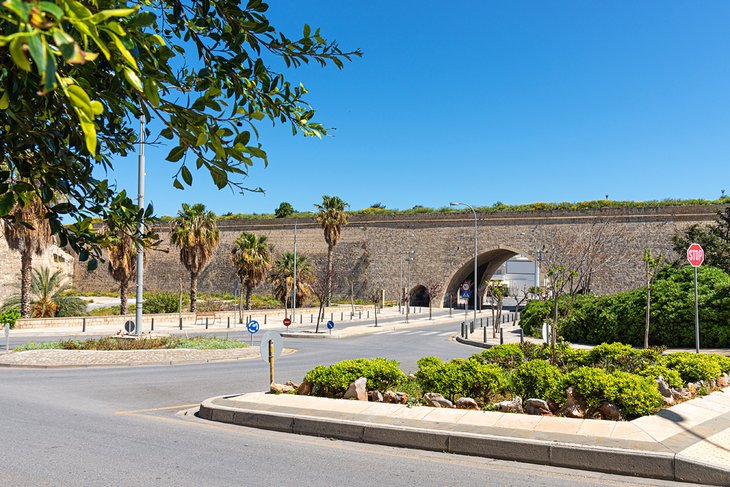
The Old Town area of Heraklion is surrounded on three sides by massive Venetian Walls that tower above the surrounding city. The walls date from the Middle Ages but have been improved and enlarged over the millennia. Today, after much hard work and persistence, the walls have been restored to their former glory, and today are a favorite spot for locals and visitors alike to walk and explore.
Access is generally near a gate, and once on top of the walls, your views out over the Old Town and surrounding areas are impressive. The walls stretch for approximately 4.5 kilometers.
Ammoudara Beach
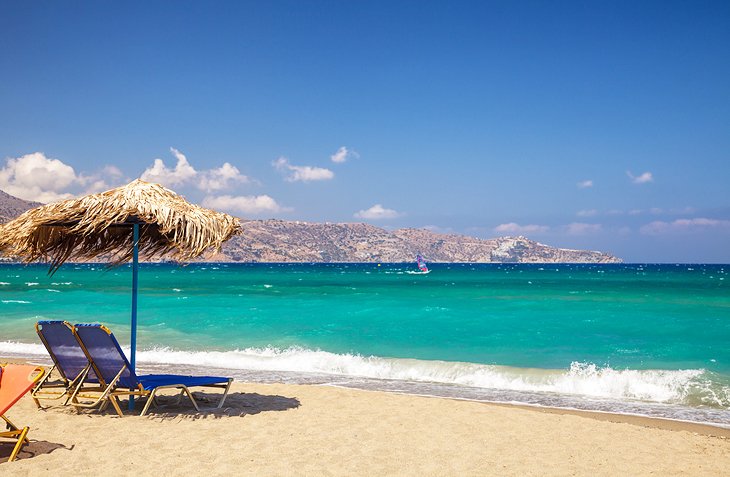
Only five minutes from downtown Heraklion is Ammoudara Beach. Golden sand and clean, clear waters backed by tavernas await the sun starved.
Small to medium sized waves, perfect for bobbing about in, are usually common here as is a cooling breeze. Sun beds and umbrellas are free to use if you purchase drinks or food from one of the roaming waiters. The beach is long and fairly wide, also perfect for strolling.
If the wind is up, this is one of Crete's most popular spots for kiteboarding. A kite school offering lessons and rentals is located right on the beach should you wish to try your luck at this fast growing, adrenaline-pumping sport.
El Greco Museum, Fodele
In the 16th century, Heraklion was home to an important school of religious icon painters. One of its members, Domenikos Theotokopoulos (1541-1614), went on to become a world-class artist, better known as El Greco.
He was born in the humble village of Fodele, set amid orange groves 28 kilometers west of Heraklion. Today, the stone cottage where he was born is a museum. Theotokopoulos moved to Spain in 1577 and lived and worked there until his death. His paintings are noted for their intense color and drama, and you can see several reproductions of his works here.
Address: Fodele, 71500 Heraklion, Crete
Cathedral of St. Minas
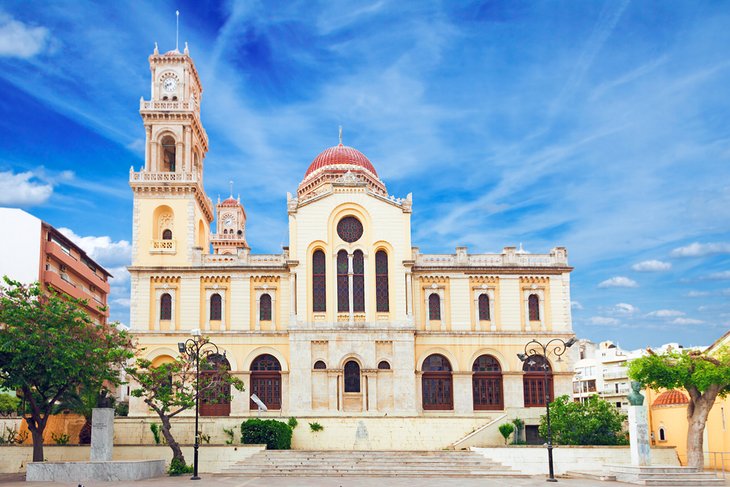
Fans of historic churches will want to be sure to swing by the impressive Cathedral of St. Minas. This building was started in 1862, and work continued for 33 years until its completion in 1895.
The cathedral is usually open, so take a few steps inside and gaze up at the impressive frescoes on the walls and ceiling. Also of note are the colorful stained-glass windows. Depending on the time of day you visit, the light shining through them is mesmerizing. At the front of the cathedral near the altar is a massive chandelier.
Cretaquarium Thalassocosmos
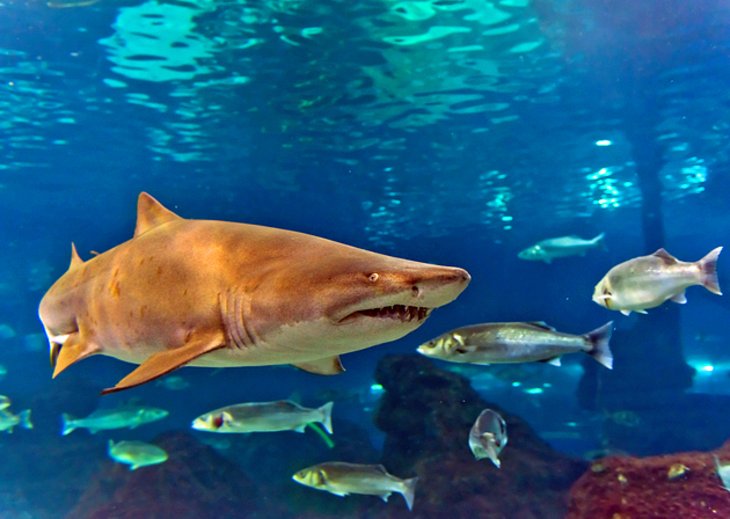
At this huge modern aquarium, you can see 2,500 marine species from the underwater world of the Mediterranean, swimming around in 1.7 million liters of seawater.
A fascinating day out for kids and adults alike, it has 32 vast glass tanks displaying everything from hunter sharks to minuscule seahorses, jellyfish, turtles, lobsters, and octopus, all in beautifully-lit turquoise sea water against a backdrop of rocks, sand, and seaweed.
The aquarium is located at a former American military base in Gournes, 13 kilometers east of Heraklion. A lovely on-site café with outdoor seating serves quick bites and cold drinks.
Address: Gournes, 71003 Heraklion, Crete
Official site: https://www.cretaquarium.gr/en
Day Trip to Matala

The long and wide stretch of beach at Matala is protected on two sides by rocky headlands, creating a calm, clear beach, perfect for swimming. On one side, the rock face is riddled with caves, which make this one of the most unique beaches to visit on Crete. The other side is home to restaurants that overlook this beautiful stretch of sand and the turquoise waters of the bay.
Overlooking the Libyan Sea, 67 kilometers southwest of Heraklion, Matala is one of the most visited resorts on Crete's remote south coast. Unlike places like Plakias, where tourists tend to spend several days or more, Matala is more of a day-tripping destination and does not have much by way of seaside accommodation. Hotels and other amenities are located in the town, back from the beach, although restaurants line the edge of the beach and one entire side of the bay.
Matala was made famous by the hippies in the 1960s, who lived here in the caves at the end of beach, including Joni Mitchell, who even wrote about it in the song Carey.
No one is certain how Matala's extraordinary caves were made-some archaeologists believe they were Roman or early Christian tombs.
Day Trip to the Palace of Phaestos
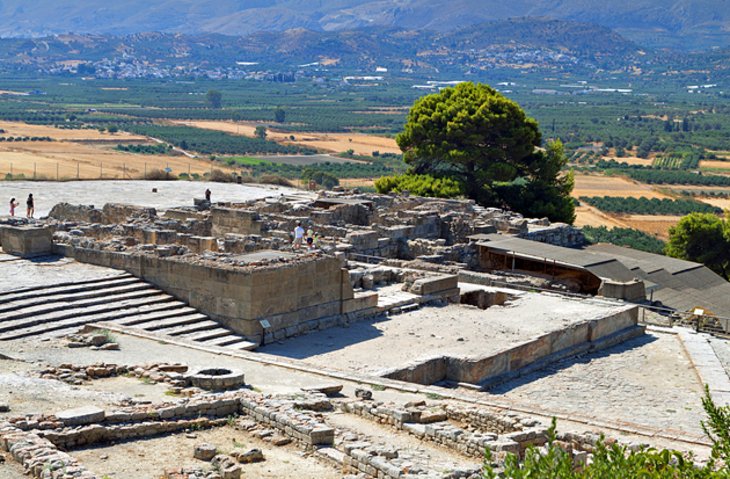
Phaestos is another magnificent Minoan palace, which some people prefer to Knossos, as it is unrenovated and more atmospheric. What you see today are the ruins of a palace, built around 1600 BC, centering on a spacious paved courtyard and beautifully located on a sunbaked hillside backed by the rugged heights of Mount Psiloritis overlooking the deep blue Libyan Sea.
The views from the site are spectacular, and in summer, it catches a blissful cool breeze. Phaestos was abandoned around 1400 BC, the same time as Knossos, and archaeologists still have to find a good explanation why. It lies 62 kilometers south of Heraklion, just a 15-minute drive from Matala.
Heraklion, Greece - Climate Chart
| Average minimum and maximum temperatures for Heraklion, Greece in °C | |||||||||||
| J | F | M | A | M | J | J | A | S | O | N | D |
| 15 9 | 16 9 | 17 10 | 20 12 | 23 15 | 27 19 | 29 22 | 28 22 | 27 19 | 23 17 | 20 13 | 17 11 |
| PlanetWare.com | |||||||||||
| Average monthly precipitation totals for Heraklion, Greece in mm. | |||||||||||
| 91 | 76 | 58 | 31 | 15 | 3 | 0 | 0 | 20 | 69 | 58 | 76 |
| Average minimum and maximum temperatures for Heraklion, Greece in °F | |||||||||||
| J | F | M | A | M | J | J | A | S | O | N | D |
| 59 48 | 60 48 | 62 50 | 68 54 | 74 59 | 81 66 | 84 71 | 83 71 | 80 67 | 74 62 | 68 56 | 63 52 |
| PlanetWare.com | |||||||||||
| Average monthly precipitation totals for Heraklion, Greece in inches. | |||||||||||
| 3.6 | 3.0 | 2.3 | 1.2 | 0.6 | 0.1 | 0 | 0 | 0.8 | 2.7 | 2.3 | 3.0 |
More Related Articles on PlanetWare.com
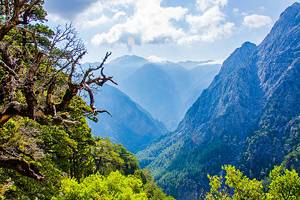
Exploring Crete: For ideas on how to spend your time and what to see on this beautiful Greek Island, see our guide to the Tourist Attractions on Crete. One of the most popular tourist destinations is the seafront city of Agios Nikolaos. The outstanding nearby beaches, shopping, and great dining will make you want to linger here. Other good options are Rethymnon, with a similar atmosphere to Heraklion, but smaller, and the scenic city of Chania.
